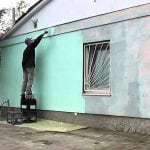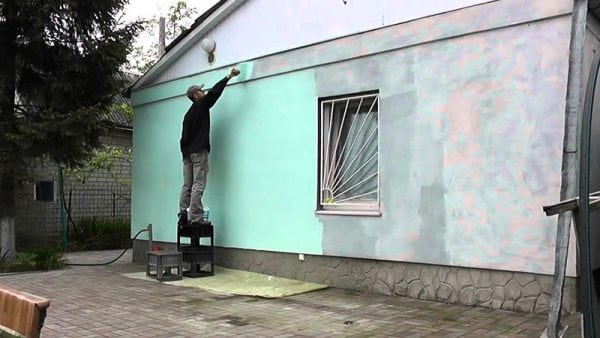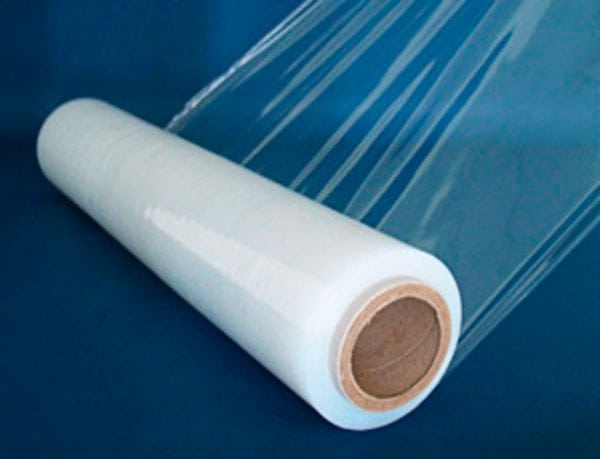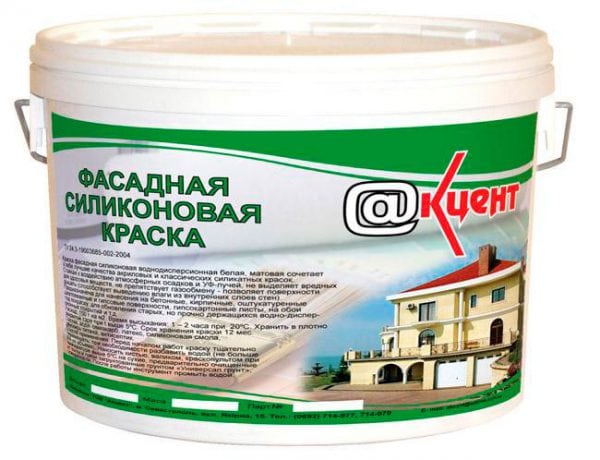Painting the facade of the house is a responsible process, since the quality of the work performed directly affects the appearance of the whole house. The painting itself consists of several stages and the implementation of each of them will affect the quality and price characteristics of the entire work.
- How to calculate paint volume
- What you need to know when choosing a material for painting
- Types of paints
- Prepare the surface
- Facade painting - finish stage

How to calculate paint volume
Before you paint the facade of the house, you need to calculate the amount of paint with a margin of 10%. You can calculate the volume based on the information on the label. On each bank, the paint consumption per 1 sq. M is indicated, the consumption depends on the type of paint. For example, oil paint needs 150 grams per 1 m2, water-based 300 g per 1 m2.
Formula paint calculation, we multiply the initial data: the area of the walls to be painted in m2 * by the specific paint consumption l / m2 number of layers (2-3) * safety factor 1.1.

The flow rate can vary in the range of 0.1-0.25 l / m2. Experts recommend that it is better to choose the flow rate downwards for smooth, dense surfaces; for textured and rough walls, a large flow rate is suitable.
In general, the calculation is not complicated, but if you are not sure, the seller in the hardware store will help you calculate correctly, in online stores of building materials you will find paint volume calculators.
Painting the facade of the house includes the stages of preparation and technology, which are tested by experience and time, confirmed by specialists.
to contents ↑What you need to know when choosing a material for painting
Do not save and buy the cheapest option. As experience shows, such a material is not durable and quickly loses its original appearance. On the packaging of the can should be indicated that the paint is intended for outdoor use. And most importantly, the composition must include a binder component, it forms a protective film, from which the material will gain a margin of durability and strength, protect the surface from chips and cracks. It is also important that the composition includes a substance that prevents the growth of mold, fungus (antiseptic).
to contents ↑Types of paints
To paint the facade with your own hands, you need to learn about the existing types. Here are the most popular and correct paints for stucco facadesto consider for selection:
- Acrylic paint. The main component is organic acrylic resin. High resistance to moisture and pollution, environmentally friendly, durable. Acrylic is considered a universal solution, it is great for painting concrete, brick, chipboard, wood, etc.
- Water based paint. Non-toxic, resistant to temperature extremes, does not fade, prevents the penetration of moisture. Consists of coloring pigment and water. After application, it acquires the effect of a brilliant color film. It is better to apply in two layers, the time for drying the layer is no more than 2 hours.
- Oil paint. It consists of drying oil, coloring pigment and filler. Among the advantages: economical consumption, durable, gives a long-lasting effect of saturated color.
- Silicone paint for facades. It is resistant to atmospheric phenomena, to pollution, does not absorb moisture. These paints are distinguished by a palette of saturated and bright colors.
- Acrylic silicone paint.They have an absorbent property, have low vapor permeability, and are resistant to fading.
To paint the exterior walls you will need the following tools:
- Choose brushes for painting the facade. You will need special brushes for painting frames, baseboards, edging - 30-50mm, more than 50 mm - for painting doors, openings, small areas, 150 mm - for painting wide surfaces.
- Choose a roller. A good roller should have a fluffy and thick pile, it is better absorbed into the composition, when applied, there will be no sagging and splashing. You can choose a roller made of synthetic bristles or sheepskin or natural mohair. Rollers should also be selected based on the purpose of painting: plastered, smooth surfaces - with a short pile of about 6-9 mm, for textured, uneven surfaces with a pile of 12-25 mm.
- You will need containers, gloves, masking tape.
- Preparing the primer. It will be needed for applying a preliminary coat, before painting and for smoothing areas after plastering.
- If you need to remove the old coating, you will need a sandblasting machine.
to contents ↑
Prepare the surface
Before applying the paint, the walls should be prepared, this will serve as a guarantee of durability and strength of the applied coating. First we examine the surface, if the old paint is tight, there are no chips and dents, it is enough to clean it from dust, moss. Wipe with a stiff brush, or even better, use a pressure washer and remove all impurities quickly and easily.
If you notice that the surface of the walls is affected by moss, mold, treat the surface with a liquid bioprotective preparation. This is necessary so that the mold does not penetrate deep into the coating.
If there are places on the surface that require plastering, then it's time to do it. We apply the plaster on uneven places, close the cracks and clean it.
A sandblasting machine is necessary to remove old paint in large volumes, for example, from all sides of the facade. But, remember, after plastering the facade, it takes a long time to dry, about 1 month.
You can check the strength of the old paint, for this, take the adhesive tape and glue it to the surface, sharply remove it after a minute. If there are fragments of base left on the tape, then you need to remove the old coating, apply plaster, then the primer.
Summarize the stages of preparation:
- Cleaning from dirt, dust, mold and moss. We apply bioprotective agents against mold and fungus.
- If necessary, we perform partial or full plastering, and we smooth out irregularities.
- Apply a soil mixture.
Facade painting - finish stage
The most responsible work lies at the preparation stage. Now we come to the stage of applying color.
Before starting work, lay polyethylene under the wall of the facade to protect against drops of paint.
Experts recommend metal parts, such as nails or protruding handles, to be treated with a corrosion-resistant primer before painting.

The painting technology outside the house is not very different from similar internal work. The surface is stained in 2-3 layers. We start staining from the upper corner, right or left is not important, we spend the roller from the bottom up. Correctly paint the strip after strip, according to the principle of "step back".
The last layer is applied along, then it is painted across and finishing once more along. The application technology is not complicated, you will surely cope, and you will be proud of the result.
The best part is that you will enjoy the process done by yourself. And believe me, a little effort and your work can not be distinguished from the work of professionals with experience.




